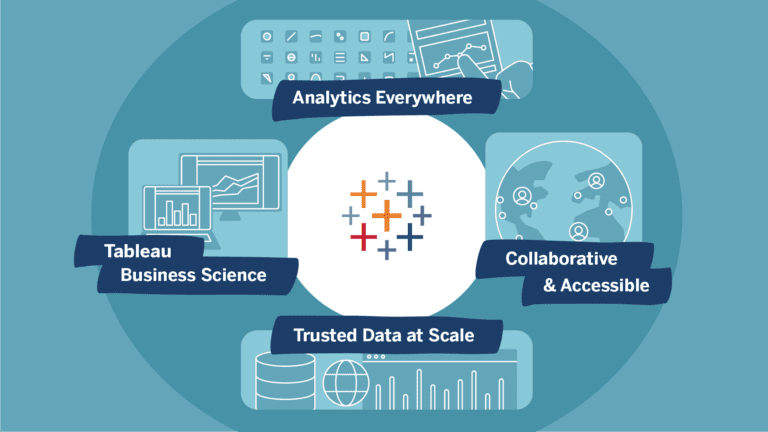At Tableau Conference, the Business Intelligence (BI) vendor announces expansions of its platform. Bringing analytics to “anyone, anywhere”, as the company itself likes to summarize its mission, plays a central role. Data and analytics must become more accessible. To this end, Tableau is aiming for far-reaching integration with Slack.
Tableau became big by helping organizations to understand data. To do this, it converts data into visual presentations. Through these presentations, patterns and trends can be discovered. Its tools are effective for finding opportunities and predicting how certain things will go. Organizations that work with data tend to make the right decisions. Therefore, Tableau wants to make analytics as widely applicable as possible.
From Tableau’s point of view, Business Intelligence has been changing in recent years. The company’s making a case for a broad ecosystem to achieve its philosophy. It is also taking advantage of the fact that Tableau is now a Salesforce company. Many product innovations focus specifically on compatibility and integration with Salesforce and related products. The announced Slack integration fits this theme, as Slack became a part of Salesforce a few months ago.
Data and analytics in Slack
During the announcement, Tableau talks about Slack-First Analytics. While there was already an integration with the collaboration platform, you can ask a question to Tableau within Slack, after which data visualizations provide answers. Users are also assisted in understanding the data. To do this, Tableau uses AI, which can explain trends in a dataset.
Furthermore, within Slack, Tableau relies on Salesforce’s Einstein Discovery, a supervised machine learning product. Einstein Discovery can look at business problems to influence Key Performance Indicators. Einstein Discovery in Slack improves employees’ trust in predictions. Among other things, predictions based on business data can identify important causes and come up with recommended steps.
Bringing such features to Slack should make it easier for users to work with data from Tableau. As dashboard and Tableau data are now available in Tableau, users are no longer required to switch between applications. It is also possible to set up alerts in case interesting data for a specific employee changes.
As far as we are concerned, despite the move to Slack seeming primarily motivated by the ambition to bring data and analytics to everyone and everywhere, the Salesforce relationship will undoubtedly play a role. For many companies, Slack is the platform on which employees communicate and collaborate — a platform with major opportunities for making analytics accessible. During a press conference, Tableau stated that, in order to reach even more employees, it would like to see if similar integrations could be set up with other collaboration apps.
Tip: The world of Salesforce now revolves around Slack
Data science for business users
Another eye-catching announcement at Tableau Conference concerns business science. With the term, Tableau refers to bringing data science techniques and capabilities to the business user without technical knowledge. After all, there is also a lot of specific knowledge on the business side. When employees become less dependent on data teams, they can more swiftly make smart decisions based on data.
For business science, Tableau introduces the Model Builder. This allows business teams to collaborate on building and consuming predictive models. As Model Builder relies on the Einstein Discovery engine, AI helps with modelling. “With Model Builder, people can build models to help predict and plan their future sales”, Tableau said.
Furthermore, Scenario Planning makes an appearance. This feature should help companies move toward better decisions by comparing different scenarios thanks to “building robust models and understanding expected outcomes, all supported by Einstein AI.”
Business science, by the way, is a direction Tableau took earlier this year. If you want to know more about the theory and what it can mean for your business, you can read our previous article on business science here.
Further new functionality
Alongside the far-reaching Slack integration and business science introductions, other innovations were featured. These mostly relate to reliable data at scale. As far as we are concerned, the following features stand out:
- Virtual Connections enable administrators to make data sources centrally accessible and ensure that they can be shared with everyone in the organization.
- Integrating Enterprise Data Catalogs (EDC) helps Tableau customers bring external metadata from data catalogues like Collibra and Informatica into Tableau. This should unify information and context in a single environment.
- Centralized Row-Level Security allows Tableau administrators to centrally configure which users and groups have access to certain data.
- Prep Extension allows users to leverage community-developed tools to simplify and improve data preparation flows. Tableau hopes it will give the community more power and flexibility for data prep.
- Share Prep Flows in Tableau Public allows users to share prep flows within the community. Practical examples are sharing best practices, standardizing, replicating and learning from others, thus increasing the success of the data prep process.
In terms of further new functionality, expanding the ecosystem is important to Tableau. Tableau Exchange plays a central role in this vision. The BI vendor calls this an evolution of the Extension gallery and a hub of integrated products, solutions and services. It should be a “one-stop-shop to browse the offerings that can help you get started with data analytics.” As part of the Exchange, there are so-called accelerators. These are pre-built dashboards for specific industries, lines of business and Salesforce Clouds.
Tableau continues to be an innovative BI platform
All in all, Tableau is packing quite a punch at its annual conference. As a part of Salesforce, it continues to innovate in several areas for both Salesforce customers and other users. Despite regular releases already demonstrating the latter, the Tableau Conference leaves no doubt. We are therefore curious to see how the BI platform continues to develop in order to make analytics accessible and bring it to everyone, everywhere.
